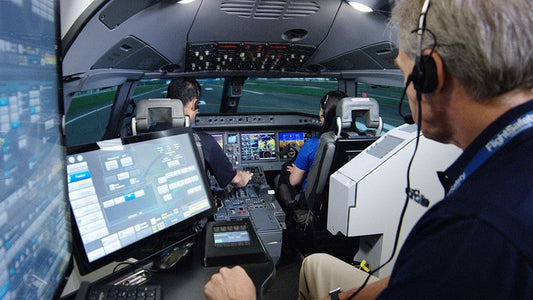The Benefits of Simulation Training – All You Need to Know

What do professional pilots, racers, doctors, construction workers, military personnel, and even gamers have in common? Simulation training! One way or the other, people in all these fields go through intensive training in a simulation that enables them to become who they are in real life.
There are many benefits of simulation training as is evident by its large-scale implementation across various industries. A key benefit of training with simulators is that they let you train in highly sensitive and big-stakes environments without ever worrying about messing up.
It offers a risk-free, cost-effective way to develop skills in a virtual and realistic environment but without any real-world consequences.
What Is Simulation Training?

In simplest terms, simulation training is a learning-by-doing experience without actually doing it. It makes use of technology like virtual reality, augmented reality, and computer-generated imagery to recreate lifelike environments in which people have the opportunity to practice skills, troubleshoot and make decisions.
The premise is simple: you do what you would do on the job; i.e., learn skills, make decisions, and solve problems but without any risk of harm or damage since you're not doing the actions for real. Due to such benefits of training with simulators, this form of training is highly recommended in high-risk situations like those typically found in aviation, medical, construction, and even military fields.
You not only get better at technical tasks but also improve critical thinking. In addition, simulation training also builds confidence, boosts reaction time, and aptly prepares you for complex tasks that would be otherwise expensive or difficult, probably both, to recreate in real life.
Types of Simulation Training

VR and AR Simulations
In these types of simulations, digital replicas of real-world environments are recreated where learners interact with objects and situations. VR puts you in a fully virtual world with the help of dedicated headset devices whereas AR adds virtual elements to the real world, like guiding technicians through a repair job with visual instructions.
Computer-Based Simulations
These are software-based programs that mimic real-life systems to teach technical skills like learning how to fix equipment, manage business scenarios, or code without touching actual hardware.
Role-Playing & Live Simulations
Role-playing & live simulations are often used in sales, customer service, and leadership training. Role-playing simulations put people in real-world conversations or conflict situations so they can practice communication and problem-solving. In live simulations, people act out real-life emergencies or medical situations in real time.
Game-Based Simulations
Almost every physical sport or hands-on activity can now be accurately modeled in a game. These realistic game simulations feature realistic graphics, physics, and mechanics to help build muscle memory and understanding of the mechanics of the task at hand.
For example, iRacing is widely used by both new and professional drivers to improve racing skills while Microsoft Flight Simulator 2024 helps pilots learn aircraft controls and navigation in detail.
Benefits of Training with Simulators

Simulation training has become one of the most effective ways to prepare people for real-world tasks, especially in high-risk or skill-intensive industries. It offers a long list of benefits that traditional training often can’t match. Let’s take a closer look at some of the biggest benefits of simulation training:
Safer Learning Environment
The biggest benefit of training with simulators is indeed safety. Individuals can learn how to react to dangerous, high-stress situations (i.e., firefighting, airplane piloting, operating heavy machinery, and life-threatening medical situations) without the immediate threat of placing themselves in harm's way. When an individual makes a mistake in a simulation, no one gets hurt and nothing gets damaged. It’s a perfect, no-risk environment for beginners who require learning through error without the threat of costly injuries.
Better Learning Through Hands-On Experience
People learn by doing and that's exactly what simulation offers—even for complex or technically complicated skills like welding and surgery. Like a video game, you can restart as often as you need to get the motions right. It fosters muscle memory and critical thinking skills as well as boosts one’s self-esteem. Therefore, people remember what they've learned more than if, hypothetically, they were just taught.
Cost Effective and Resource Saving
Training in the real world often requires expensive equipment, materials, or setups. Simulators cut these costs dramatically. This is yet another benefit of simulation training as trainees can learn without using up real-world resources like fuel which saves money and reduces wear and tear on machines. It’s a one-time investment that keeps saving money over time.
Realistic Environments, Real Results
Simulators recreate real-world environments so accurately that they feel just like the real thing. From weather conditions and machinery behavior to human anatomy or workplace layouts, they recreate real-world scenarios with surprising accuracy. This realism helps users feel like they’re in the actual environment where the immersive experience helps them learn by doing and not just by watching or reading theories.
Flexibility and Accessibility
Because simulations aren't time-specific and don't require specific training rooms, learners can train whenever and wherever. This is a big benefit of training with simulators for teams that span geographical borders or time zones. Any time a new team member is added to the roster, training can be done at any time and in any place.
Instant Feedback for Faster Improvement
Many simulators give instant feedback. As the user engages, they learn in real-time as to what they are doing right or wrong. As such, they don't have to wait for a trainer to notice something wrong; they can adjust in the moment to learn faster. This real-time response facilitates quicker learning and efficiency in skills development and decision-making.
Builds Confidence and Reduces Anxiety
Another benefit of simulation training is that when learners know that their mistakes won't cost them their jobs or be too harmful to their learning process, they're more likely to play around with failing, learning, and trying again. Practicing in a no-fault environment builds confidence so that when they're ready to take their skills to the real world, they've already practiced it with lowered stakes. This creates not only productivity but also the kind of confidence that goes a long way when it's time to perform at work.
Scalable for Teams and Organizations
Simulators can be used to train many people at once. This is perfect for companies or organizations with big teams. They allow entire teams to practice together, build communication, and coordinate responses in group scenarios; all without needing physical space or equipment for every person.
Tracks Performance with Data
Yet another benefit of simulation training is the ability to track performance. Should trainers or companies want to know how well each user did, detailed reports are available to gauge not only what skills are lacking to identify skill gaps but also to tailor training regimens based on factual information per user.
Better Decision-Making Skills
Simulations put trainers in situations where they’re required to think on their feet and troubleshoot the issue at hand. While they will be making mistakes in the beginning, over time, this will improve their ability to make effective decisions quickly.
Environmentally Friendly
Since simulators don’t burn fuel or consume physical materials, they’re much kinder to the environment. They help reduce emissions, waste, and wear and tear on machines, all the while still delivering high-quality training. This adds yet another point to the long list of benefits of training with simulators as it’s a greener and cleaner way to train, something that almost every organization values today.
Industries Where Training Simulation Is Applied

There's a range of industries that use training simulation—and rightfully so. It offers real-world experience without the real-world danger, and in a safe, cost-effective way. Here are some of the major sectors where it’s making a big impact:
Medical professionals utilize simulation training to learn surgical procedures, critical care, and emergency treatment. This lets doctors and nurses train and hone their skills without ever putting lives on the line.
Aviation has been using simulation training for decades. Pilots learn how to take off and land, air traffic controllers learn the audio language to prevent confusion with pilots, and flight attendants practice emergency evacuation procedures—all without leaving the ground.
Military training often involves simulation as it's necessary for soldiers to train for combat, explosive detection, and hostage situations. Practicing in simulated environments empowers soldiers to make the best decisions when under duress and pressure without putting lives or assessment devices at risk.
In construction and engineering, workers train on machinery and complex tasks through realistic site simulations. This lets them learn how to operate machines, follow safety procedures, and manage building projects in a virtual environment before stepping onto a real site.
Business and management teams use simulations to practice decision-making, leadership, and crisis response in dynamic virtual business environments.
Even education and customer service sectors benefit, with teachers and call center staff using simulations to improve communication, conflict resolution, and day-to-day operations.
Final Thoughts
Simply put, the benefits of simulation training stretch across nearly every field today that values safety, skill, and performance. As of today, it has changed the way we learn and train for our roles. What do you think? Share your thoughts with us and let us know in the comments down below!





